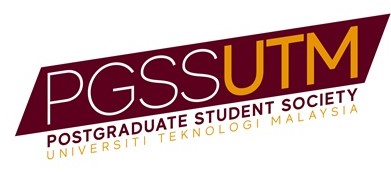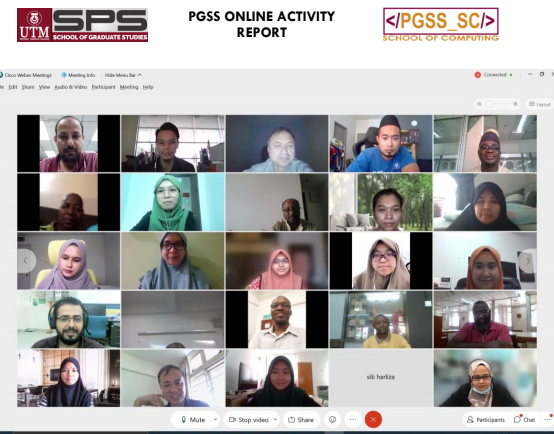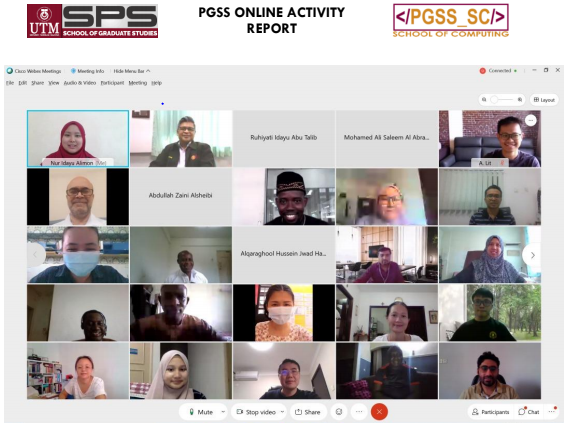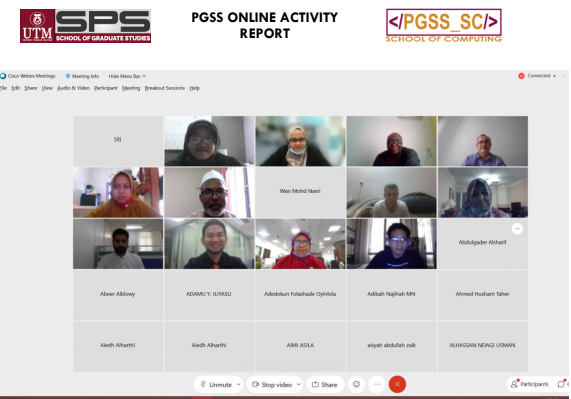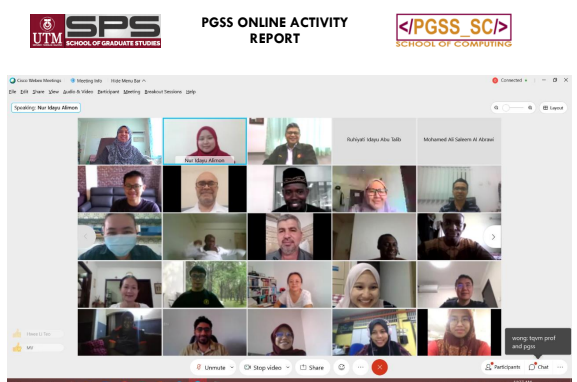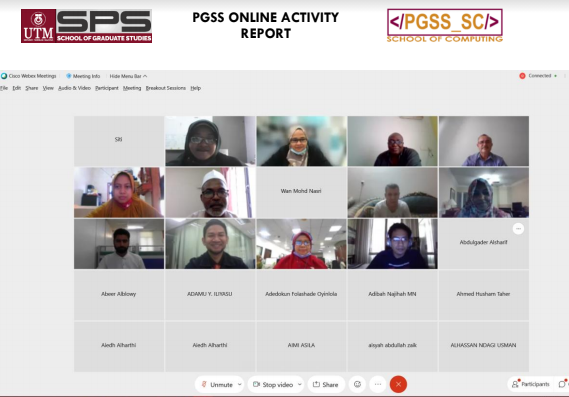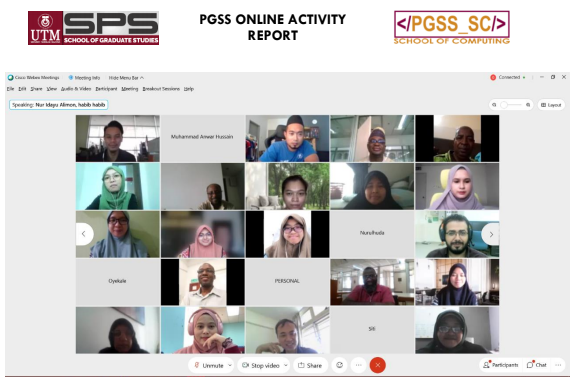On April 26th, 2021, an online structured course entitled ‘Pitch Perfect: How to Ace Your Ph.D. Viva’ was organized to share information related to the viva process and tips on tackling the viva process smoothly. The structured course started at 9.00 am and ended at 11.40 am using Cisco Webex online conferencing platform. This course was organized by the Postgraduate Student Society School of Computing (PGSS-SC), Nur Idayu Alimon, as the moderator and co-speaker.
This session was successfully held with the PGSS-SC committee’s help: Muhammad Zafran Muhammad Zaly Shah, Asraful Syifaa’ Ahmad, Muhamad Farhin bin Harun, and Muhammad Luqman Mohd Shafie. This course received 446 online registrations, and 308 participants turned up for the event. However, out of 308 only 306 participants registered during the structured course. There are 69.93% Ph.D. students, 17.64 % Master’s degree students, 0.98 % Bachelor students, and the rest are unidentified. And the rests are UTM staff or non-UTM participants.
The honorable speaker for the program is Prof. Habibollah bin Haron. Prof. Habibollah is a Professor in the School of Computing, Faculty of Engineering, Universiti Teknologi Malaysia (UTM). Previously, he is seconded as President of Qaiwan University (QU), Sulaymaniyah, Kurdistan-Iraq. This secondment is part of the commitment from UTM to ensure the success of the QU-UTM Franchise as part UTM Trans-National Education agenda.
He received a Bachelor of Computer Science from UTM in 1989, Master of Science in Computer Technology in Manufacture, from the University of Sussex, the UK in 1995. In 2004, he received his Ph.D. in Computer Science specialization in Computer Aided Geometric Design (CAGD) area from UTM. For his Ph.D. program, he has stayed two years in Cardiff University, UK, as part of his research program attachment. He has research experience in robotic, image processing, artificial intelligence, computer vision, and computer-aided geometric design.
Since the emerging big data analytics and data science, he is actively involved in this research area. He is actively appointed as a keynote speaker for many international conferences, reviewers of international journals, reviewers of international and local research grants, examiners for Ph.D. and MPhil thesis for Malaysian and international universities. He has been a Principal Investigator of many research projects, including RISE European Research Council project and national and UTM research grants. His philosophy in his academic career is the balance in the management of the higher institution and excellence in research activity.
The sharing session starts with the introduction to the grade for the viva process. The grades are:
- A: which is pass without any correction,
- B1: the supervisor only checks the correction, the duration is three months,
- B2: internal examiner (external examiner is not compulsory) must check and verified the correction. The duration is six months,
- C1: thesis and experiment must be The thesis is re-evaluated and does not require re-viva. The duration is one year.
- C2: thesis and experiment must be The thesis is revaluated and require re-viva. The duration is one year.
Before the viva, the student must prepare the slide, and the presentation must not exceed 30 minutes. The presentation is to showcase the presentation skill of the student as a researcher. Besides that, during the viva, the student needs to bring a copy of their thesis, both hardcopy, and softcopy. Before the viva, to reduce the nervous level, students need to bear in mind that examiners are trying to improve their thesis and not try to condemn the student’s hard work. Hence, mindset as a student that viva is a medium of sharing session of the research done by the student. The requirement for viva is that the student must have two SCOPUS publications either from a journal or conferences. The thesis also needs to have clear contributions in the objectives which should also be related to each other. According to the co-speaker, preparation for Viva is very important. Students must refer to their supervisor, and mock viva is compulsory as the preparation for the viva presentation.
During the viva, the student must avoid being over-confident or under-confident because it could affect their emotion during the question and answer (Q&A) session. A lot of high-impact publications are not guaranteed a good viva grade. However, the skill of presentation is not significant in determining the student’s grade. The skill of answering questions during Q&A sessions and thesis writing is crucial in determining the viva overall result. The student also needs to answer the question correctly and avoid saying anything unnecessary. In order to get a satisfactory viva result, which is B1 and A, make sure the thesis is complete, follow the format, and have reliable references related to the thesis. Make sure the thesis also well organized and robust methodology. Besides that, every citation needs a thorough analysis.
There are three stages in the viva process. The first part of the viva starts with the chairperson will introduce the student to examiners and vice versa. There also assistant chairperson who is tasked to write all the correction needs to be done by the student based on examiner’s feedback. Before the student proceeds with the presentation, the student will be excused from the viva room for a discussion among examiners, chairpersons, and supervisors to discuss the initial grade based on the thesis. The chairperson’s role is also to conduct the initial grading discussion and decide if the presentation is required or not.
If the initial result gathers positive feedback from the examiners, the student can proceed to the second phase. The second phase is the presentation from the student. After the presentation is finished, the process proceeds to the Q&A session. The session involves general and specific knowledge about the research. Then, the examiners will go through the thesis chapter by chapter in detail.
After that, reference, appendix, abstract with the translation and thesis title is evaluated. Lastly, for the third phase, the student will be excused again from the room, and examiners will proceed with the overall grading discussion. After the discussion is finished, the student is called back into the room and informed of their grade. Then, a photography session is conducted.
After the viva, the student must do a proper correction based on the chairman’s report. All corrections must be done thoroughly according to the chairman’s report. After the related parties approve the correction, the student will proceed to the hardcover process and waits for final approval from the senate. If there no problem at the senate level, the student will soon receive a letter that indicates they have completed their Ph.D. study.
After sharing session is finished and proceed to the Q&A session to answer various questions from the audience. The program is ended at 11.40 am, and before closing the ceremony, a photography session is conducted. There no issues during the program. Nevertheless, the participants appreciate all the efforts by the SPS UTM and PGSS SC as the organizers. Additionally, 98.04% of participants rate this structured course 4 and 5 stars in terms of the overall rating. This course outcome is a kick start for PGSS SC to organize more sharing sessions like this.
